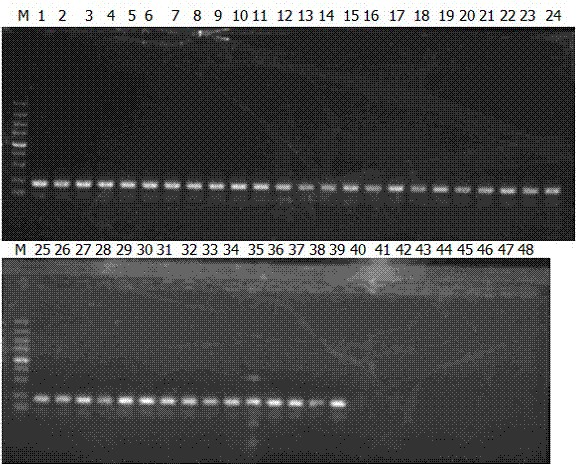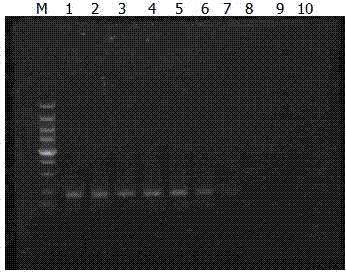Primer pair for detecting listeria monocytogenes and method for detecting listeria monocytogenes
A technology for mononucleosis and Listeria, applied in the direction of microorganism-based methods, biochemical equipment and methods, microorganisms, etc., can solve the time-consuming and labor-intensive preparation of the biochemical characteristics of the medium, and is not suitable for the needs of rapid food detection, etc. problems, to achieve the effects of short detection time, simple result judgment and specific detection results
- Summary
- Abstract
- Description
- Claims
- Application Information
AI Technical Summary
Problems solved by technology
Method used
Image
Examples
Embodiment 1
[0046] Establishment of PCR detection method for Listeria monocytogenes
[0047] Step 1, design primers according to the conserved sequence in the genomic DNA sequence of Listeria monocytogenes, and find the specific gene lmo0202 from the genome sequence of Listeria monocytogenes hly The gene is used as the target gene of the Listeria monocytogenes gene, and the gene sequence is shown in hlyID NO:1;
[0048] Enter this gene sequence into the primer design software Primer Premier 5.0 to design primers, and the product size ranges from 100 to 500 bp, and then screen for suitable primers.
[0049] hly-F:5'-ATC AAC CAg ATg TTC TCC CTg TA-3'(hly ID NO:2)
[0050] hly-R:5'- gAT TCA CTg TAA gCC ATT TCg TC-3'(hly ID NO:3)
[0051] Step 2, Preparation of DNA template
[0052] 39 strains of Listeria monocytogenes and 8 negative strains (Listeria ovis, Listeria innocuci, Listeria seir, Listeria gasseri, Listeria weideri, Salmonella choleraesuis , Salmonella typhimurium, Serratia mar...
Embodiment 2
[0060] Example 2: Accuracy evaluation of PCR detection method for Listeria monocytogenes
[0061] Using the PCR detection method for Listeria monocytogenes established in Example 1, detect whether artificially contaminated meat samples contain Listeria monocytogenes. Pick a single colony of Listeria monocytogenes from the LB plate, insert it into 50mL LB liquid medium, and incubate at 37°C for 12h. Make a 10-fold gradient dilution with normal saline, and take 1 mL of dilution to 10 -8 The bacterial liquid was counted on the plate, and the initial concentration of pure culture of Listeria monocytogenes was calculated. 40 pork samples, aseptic sampling 25mL, insert 1mL 10 -2 Serially diluted Listeria monocytogenes suspension. Add 40 artificially contaminated samples to 225 mL LB liquid medium. Bacteria were enriched in a shaker (120r / min) at 37°C. Sampling was performed once after 12 hours. Take 1 mL of each sample, put it into a 1.5 mL centrifuge tube, and centrifuge a...
PUM
 Login to View More
Login to View More Abstract
Description
Claims
Application Information
 Login to View More
Login to View More - R&D
- Intellectual Property
- Life Sciences
- Materials
- Tech Scout
- Unparalleled Data Quality
- Higher Quality Content
- 60% Fewer Hallucinations
Browse by: Latest US Patents, China's latest patents, Technical Efficacy Thesaurus, Application Domain, Technology Topic, Popular Technical Reports.
© 2025 PatSnap. All rights reserved.Legal|Privacy policy|Modern Slavery Act Transparency Statement|Sitemap|About US| Contact US: help@patsnap.com


